Studio Visit
Art Star Christina Quarles on the Joys of Her ‘Chunky’ Studio in the U.K. Countryside, and the Home Depot Purchase She Can’t Do Without
We caught up with the California artist while she is in residence at Hauser and Wirth Somerset.
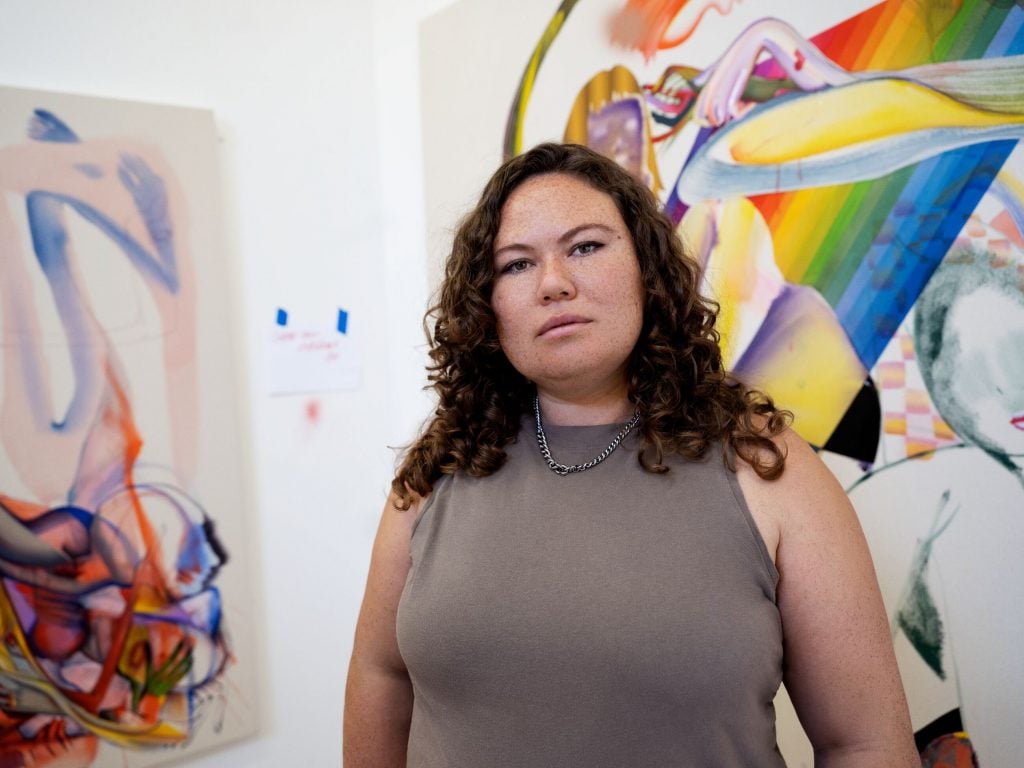
We caught up with the California artist while she is in residence at Hauser and Wirth Somerset.

Naomi Rea

It was time for Christina Quarles to have a quiet moment. Following the birth of her daughter last November, the artist has had a hectic few months, including an outing at the Venice Biennale, where she has a suite of paintings on view in the main exhibition at the Giardini. Collectors have also been clamoring for her work after a $4.5 million auction record set in May.
Fresh from these two career-defining moments, and a brush with Covid-19, Quarles arrived at the small village of Bruton in Somerset, U.K., to take up residence in a historic building owned by her gallery, Hauser and Wirth. The 37-year-old painter has been hard at work there, slugging through an unseasonal heatwave in England, which without the luxury of air conditioning, was oppressive even for someone used to southern California summers.
Artnet News caught up with Quarles in the studio as she prepared for her first major exhibition with the gallery in New York, opening September 8.
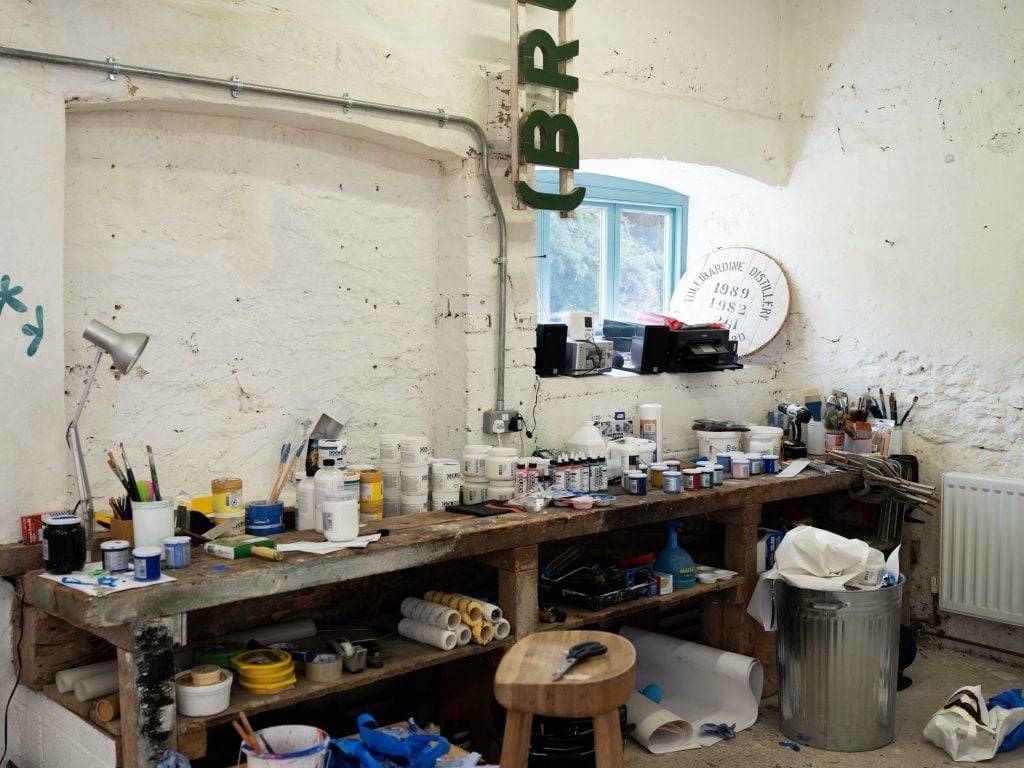
Christina Quarles, Studio View. Photo by Tara Darby. Courtesy the artist and Hauser & Wirth.
You’re working far away from your normal studio in California. Can you tell us a little bit about what the studio in Somerset is like?
The studio is an old building and from what I understand, they used to process grain here. It’s this crazy building that is unlike anything I’ve ever worked in before. There’s almost no walls—behind me are the few walls in the studio that I’m painting on, and everything else, I mean they’re walls, but they aren’t white pristine walls, they’re like crazy stonework and windows.
What has it been like working there?
It’s been really nice because it’s literally across the driveway from the house that we’re staying at. I’ve always prioritized working close to home—even in the past, if it meant working in a really tiny studio. When we last spoke in 2020, I would have been in the garage behind my house. I’m actually building a studio right now behind my house so I can have a little bit more than 300 square feet, but still be able to work from home, which is my favorite thing.
[Somerset] is similar in some ways to living in Altadena [California], just because it’s more rural there. But it’s been really nice to not have to be in the car all the time, and going on so many walks. The way that walking exists in the English countryside is really unique. You’re allowed to walk on other people’s property, and there’s all these footpaths that interconnect and it’s really special. So my “in between space” has really been a walking practice here, and it’s just cool.
You’re surrounded by quite a few paintings in the studio right now. Do you usually have so many works in progress at the same time?
No, normally I would keep about three works up and store the rest.
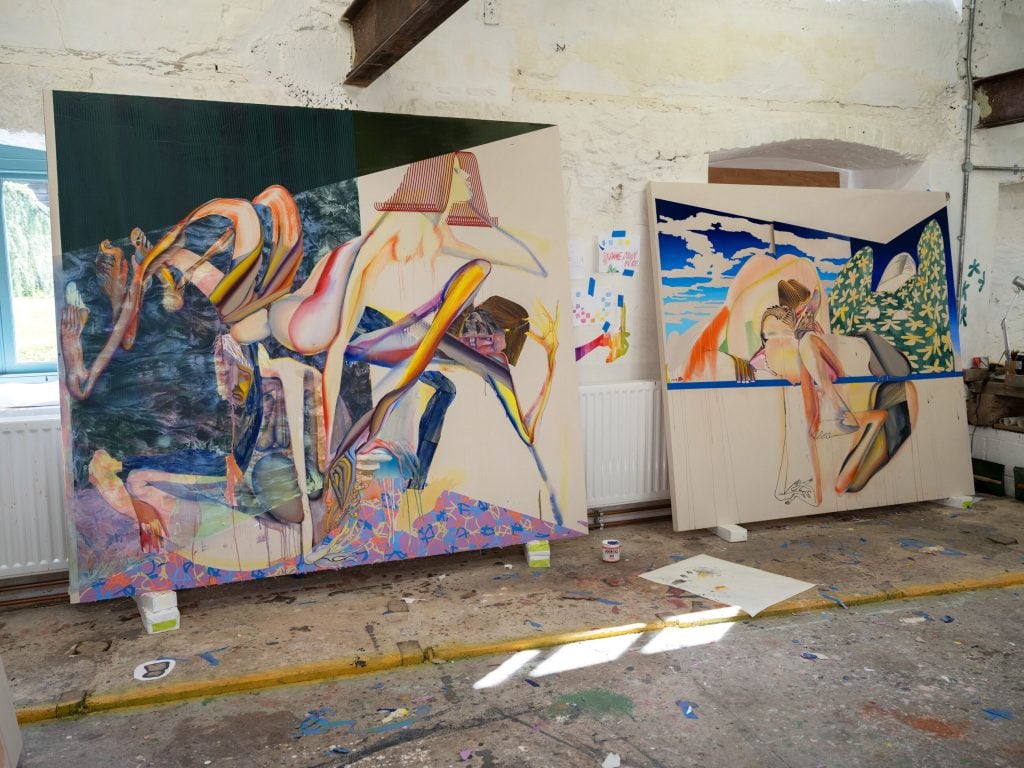
Christina Quarles, Studio View. Photo by Tara Darby. Courtesy the artist and Hauser & Wirth.
The colors are all so beautiful. Did you bring your paints with you?
The gallery bought paints based on what I work with at home. Because I work with a very limited palette—that’s the way I was taught color, was to work with this really pared back CMY palette and mix all my colors from there—when I first got here, I was like, okay, I have all the pure colors. Now, because I’ve been here for a few months, I have started to mix colors, and it’s taken me a while to build up my personal palette.
This was the first painting I made when I got here. And actually there’s moments of color in this painting which are a bit atypical for me. I think it’s because I was not working with my studio of mixed colors. I think that there’s this sort of idea or assumption that having everything at your fingertips is what would lead to creative freedom. But I sometimes find that having restrictions, or having things be a little off, or a little frustrating, can also lead to that same sense of discovery. It’s been fun to kind of restart a studio, which I haven’t done in quite a while, and especially after such a long period of time in lockdown, where I’ve really just been accumulating stuff. Being in a completely different environment instead has been really cool.
Another thing that’s been really significant, being in Somerset, is that the quality of light is different because the sky is not as polluted. You would think, “Oh, you just came from L.A., isn’t that where the colors are?” But somehow being here, I think that sort of unfiltered light has led to this real saturation of greens and blues that I’ve not seen for a period of time.
Some of the patterns and textures that we’re seeing in the paintings, are they inspirations that you’ve found in here, or did you take things with you?
It’s really important for me to be around visually stimulating things, because even if it’s not intentional, I will be inspired by everything around me. And even if I’m not meaning to, they’ll work their way into the composition.
It’s funny, there’s this painting that I started in Los Angeles, which was kind of unique in a way, because the idea behind its architectural structure is something that’s specific to a walk that I take in my own neighborhood back at home. But I was making this piece leading up to coming out to Somerset, and I was wrestling with how to deal with the stonework. And then being in Somerset, it’s nothing but stone walls. So I was like, okay, I know this is crazy, but I need to get the painting that’s in Los Angeles right now to Somerset so that I can rework the stones. Because I have been seeing how stones patinate over time.
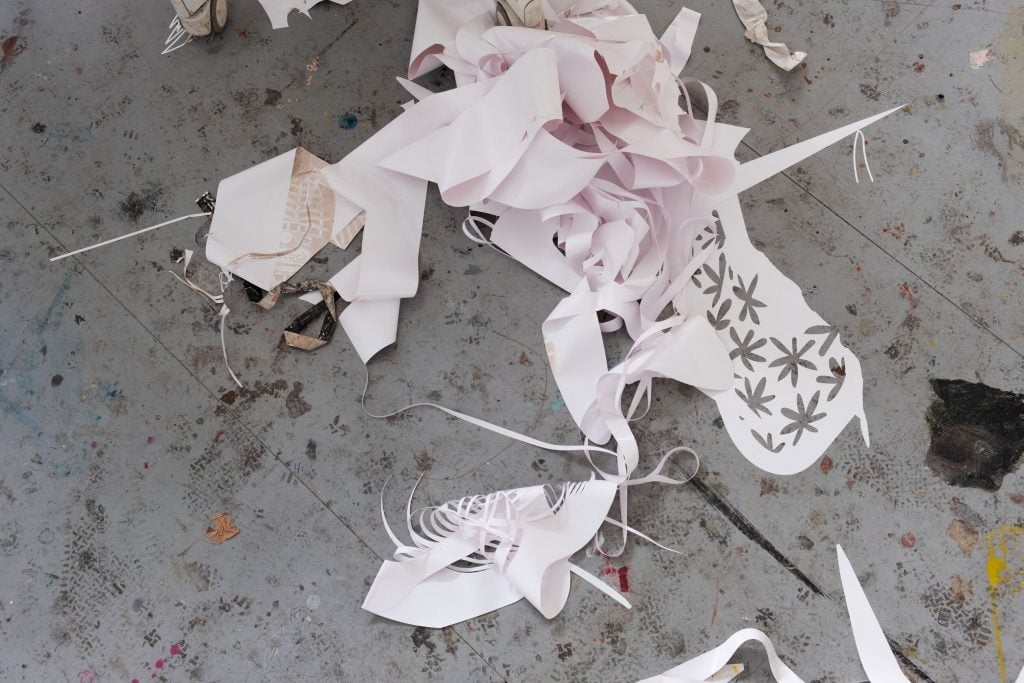
Christina Quarles, Studio View. Photo by Tara Darby. Courtesy the artist and Hauser & Wirth.
If you could think about three words to describe the space that you’re working from right now, what would you say?
Let’s see… chunky? There’s something to do with the thickness of the space, the walls are super thick, they’re also rough, and there’s these big, beautiful deep set windows here.
There’s also this sense of trickery to this space, or like an optical illusion, because from the exterior, this building I’m in is enormous. It’s like the biggest building I’ve ever seen a studio be in. And then from the inside, it actually feels like I’m working with sort of these smaller spaces, which nevertheless have these incredibly high ceilings. So it’s been really distorting my sense of the scale for my own work. I find myself having to just sort of fit my work into all these different little nooks and crannies in the studio. So, crafty, maybe?
And then just lovely, I guess. It’s been very pleasant to have this time, especially since it’s my first real return to work after having a baby, and so it’s been really nice to just work and be able to look out the window and see my family in the kitchen having lunch, and to be able to wave to the baby as I’m working, and pop in and out. It’s allowed for a lot of quality studio time and a lot of quality family time, and that’s just been really lovely.
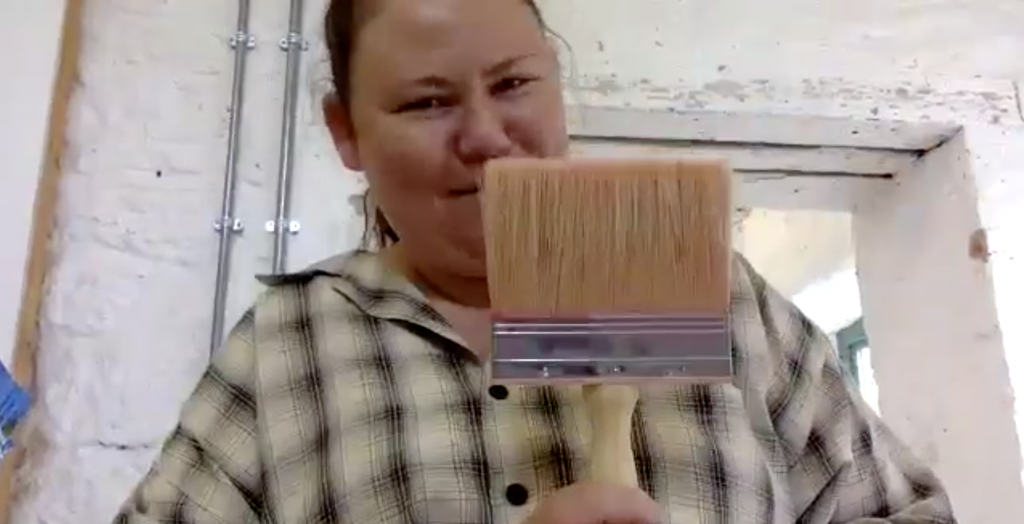
Christina Quarles and her essential five-inch stain brush.
What is the most indispensable item in your studio and tell us why you can’t live without it?
There’s one item that I went to great lengths to acquire while being here. And it’s something that if I had known how important it was, I would just have packed it with me. It’s this five-inch stain brush that they don’t make in the U.K. I could not find it online. I tried every substitute of brush and I bought like a million more trying to replicate it.
It’s weird because it was this thing that I just randomly picked up at a Home Depot in Los Angeles for like $4 and thought, “Oh, this will probably work.” And little did I know that it was the only brush that would work for this specific brush technique I wanted.
Everything else I’ve been able to sort of figure out and make do. But this was the one thing where the first group of friends I had come to visit us, I asked them to go to Home Depot, pick up two of these brushes, put them in their suitcase and bring them to me.
What about the atmosphere that you work in? In general, do you prefer silence when you work? Do you listen to music or podcasts or have someone talking to you?
I listen to music or have it be silent. Those are sort of the two modes that I like to work in, and it depends on what type of work I’m doing. The reason why I am typically working on two or three pieces at once is because I usually have this time in a painting where I’m doing much more physical work; and then when I’m doing the stencil and the thicker layers and letting those dry, that’s more of a mathematical sort of carrying out the course of actions that have already been predetermined on the computer.
And so when I’m doing the one, that’s more fluid and emotive in a way, I like to listen to the same five things over and over again. I eventually hook back into this rhythm. I have a playlist on Spotify that I’ve been making, really, since I left grad school, so I usually listen to that. And then it’s super embarrassing, but I do like to listen to musicals a lot in the studio.
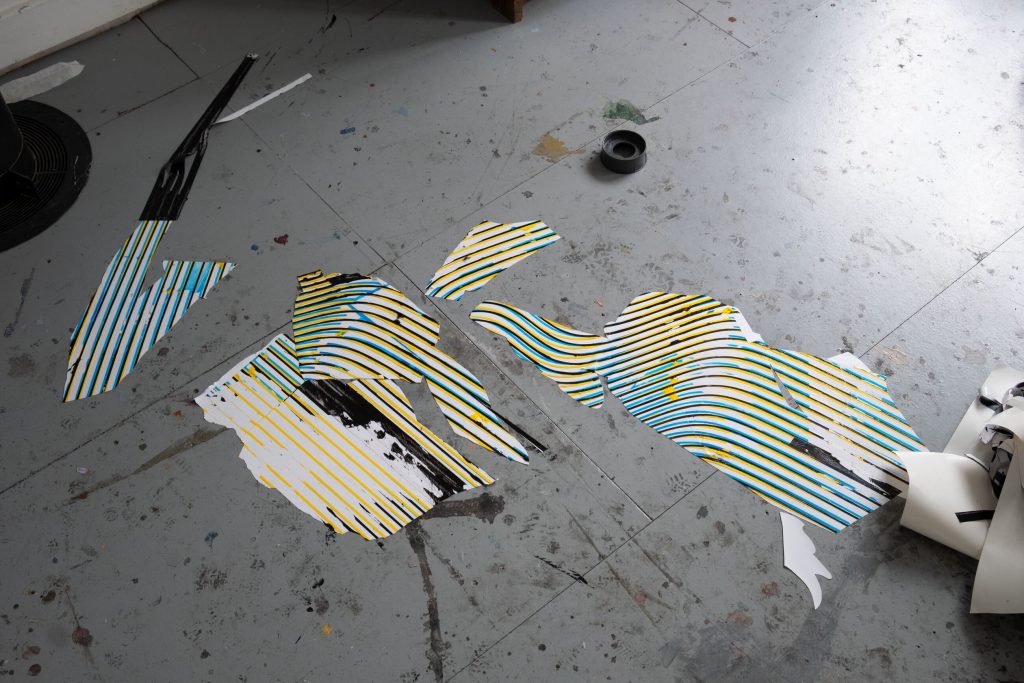
Christina Quarles, Studio View. Photo by Tara Darby. Courtesy the artist and Hauser & Wirth.
Is there any kind of environment that’s not conducive to work for you?
The one thing that I’ve not been enjoying about this space is, I usually like to work on carpeting, which is really weird, but I find that it’s like having a giant rag that I can clean my pallet knives on. And it’s something that also I can vacuum, so it gets clean so I can work barefoot if I want to. And I can lie down and look at a painting for a long period of time. And the other thing I’ve been really missing has been having a big comfy chair, because a lot of my time I do just spend staring at the work and looking at it and kind of daydreaming.
Then, I’m really a type of artist that likes to work during office hours. I love working early in the morning and I have been doing a little bit of work later here just because it stays light so late. So I guess I like to work when the sun’s out. I don’t like to mix partying and hanging out with being in the studio. I’m either working in the studio or I’m not in the studio.
Titles are important parts of your paintings. When do they come into the process?
I start to come up with the title in the middle point. Usually I’ll write something down kind of near a painting—see, this painting has a little note on the wall that says, “same shit different day,” which I think will be the title, even though I’ve never used a bad word in one of my titles and I’m very nervous about it because it seems so inappropriate. (I’m not somebody that uses curse words in front of authority figures or my mom or anything.) But it was something that was in my head as I was making that piece, and as the composition started to form I was thinking about how there’s a jumble of figures and then there’s this sort of airy potential in that transformative middle, and that results in another jumble of figures.
I’ve been thinking a lot lately about how we have all gone through this potentially very transformative global event of the pandemic and then how it has also brought out all these other injustices and inequalities—labor inequality and the large chasm between classes and access to healthcare and police systems and governments that don’t seem to be working, at least in my country. And then global warming and how that’s been exacerbated too by everything, and also is linked to all these potentials for new and more extreme diseases to be happening.
All this has been happening, and there was this moment, I think when we were talking back in 2020, where I felt very optimistic about the potential for going through this as a species all at once, and that there was this real potential for some good to come from it. I really feel like if the pandemic had somehow magically ended at the end of the 2020 calendar year, we would’ve been better people, but it just kept going. And then it reached a point where everyone just got tired and felt like, “Let’s just pretend like this doesn’t exist anymore.” And the capitalist structures that propel decisions continue to propel decisions. People all just had to try to go back to work and figure it out.
In many ways I feel like we had this moment where things could have been transformative and if anything, they transformed for the worse.
So all of that’s running through my head as I’m making this piece, which compositionally echoes that, and then it’ll be a title, like “same shit different day.” I try to not set any of them in stone until the work is done, so I can pick and choose the flow of the different titles.
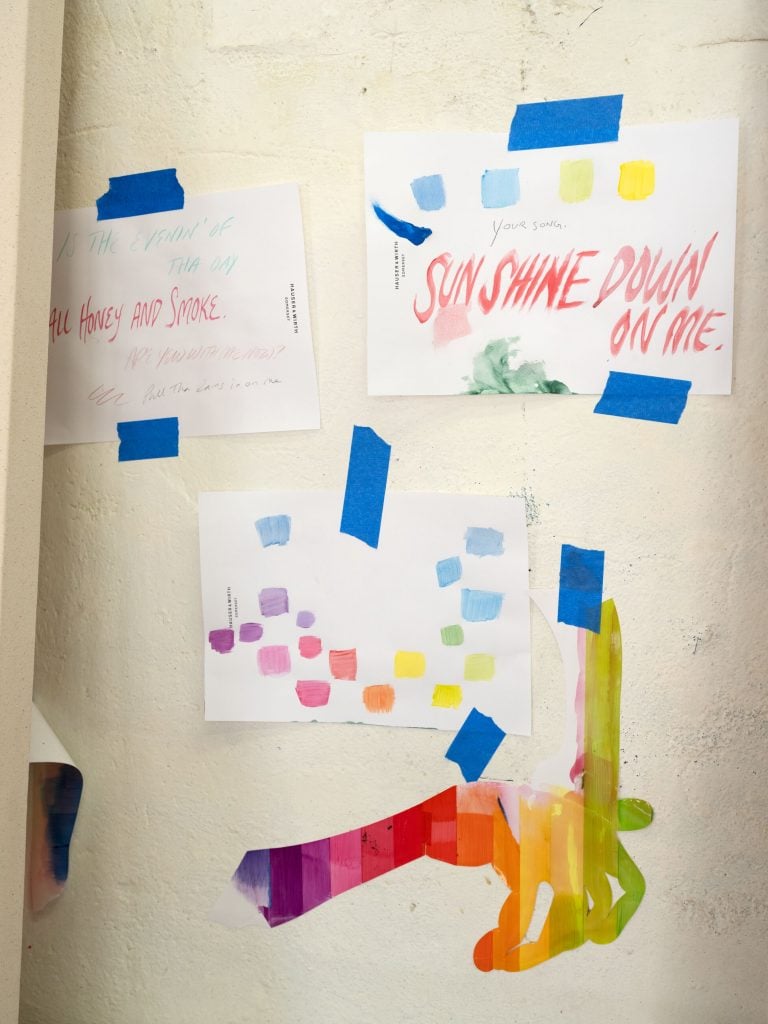
Christina Quarles, Studio View. Photo by Tara Darby. Courtesy the artist and Hauser & Wirth.
What is the last exhibition you saw that made an impression on you and why?
I really was inspired by seeing the Venice Biennale exhibition. I’ve never been to Venice or to the Biennale so aside from the thrill of seeing my own work there, it was just so inspiring to walk through the show. There’s certain curatorial exhibitions that set a tone for everything that you see thereafter.
Maybe this is self-involved because another one is an exhibition I was also in, which was “Trigger” at the New Museum. I feel like the way that people talked about gender really shifted after that show. And surrounding the Venice Biennale, the way that people are discussing surrealism as it mixes with the body, and the digital and environmental new age that we’re in, and how those all sort of intersect with feminism and gender non-binary identities, and trans identities, that’s something that now I’m starting to see in all exhibitions that are being proposed, in catalogues and books and things.
I think both of those exhibitions point to a much more dynamic and nuanced way of thinking through these broader topics that have surrounded identity politics. And I feel like the conversation each time is able to elaborate on everything that’s happened before and get more and more interesting in a way, and less reductive and didactic, and more exploratory. I love it when work can just be art and you don’t have to read wall text—as much as I love wall text—when you can see a clear, yet complex conversation emerge just from the process of being in front of a work.
And then recently I saw this show at a commercial space at White Cube of a young female artist, Danica Lundy, that I wasn’t that familiar with, and it really changed the way that I thought about seeing.
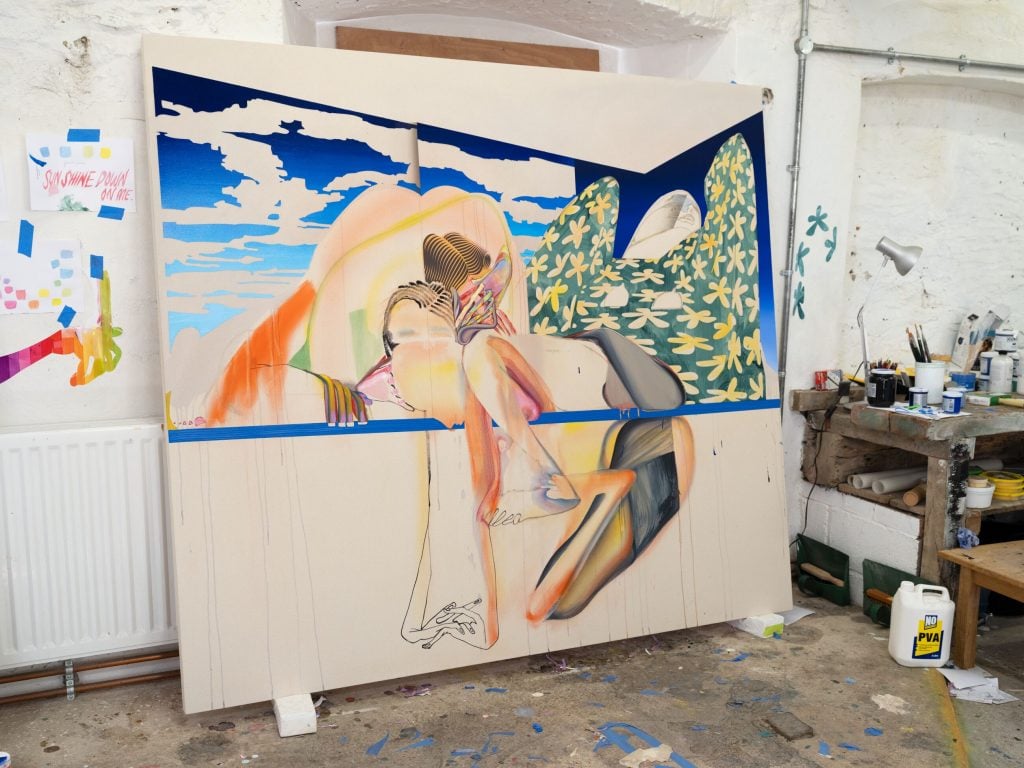
Christina Quarles, Studio View. Photo by Tara Darby. Courtesy the artist and Hauser & Wirth.
What advice would you give to other artists when they might feel stuck while preparing for a show? What do you do to get unstuck?
I was just talking to my wife about this today. In grad school, I was really struggling with the work I was making. I found it to be so frustrating because I knew what I was trying to accomplish, which was to be able to make these paintings that would be direct and clear about this idea of ambiguity and these ways of seeing that were not super clear. I wanted to do something that felt kind of contradictory. I also knew that I really wanted to take the fluidity and gestural innovation that I could accomplish with line drawings and apply that to paint. And I found it to be so frustrating because I just was not getting there.
It was this process I would describe to my wife at the end of the day: It’s like if you spent all day long trying to draw an apple, and you had the apple in front of you, you had all your supplies, and then eight hours later, you looked down and you had drawn a Ferrari. What do I do?
Her advice to me at the time, which I found really helpful, was to try a practice where, for the first five minutes in the studio, I just sit there and not do anything, and then spend another five minutes writing. It doesn’t have to be anything good or anything bad. And I started a frequent writing process after that and I found it to be really helpful. I think we fall into this feeling that you need to be productive [at all times]. And I think that a process where you can spend more time looking and transitioning can be really meaningful.
There’s an inefficiency, I think, to art-making that is really powerful. The point is that it’s something that is slow and takes time and is a skill that you don’t acquire, you just continue to practice it and you continue to learn from it. That’s what I’ve been thinking about in the studio lately, is how to be more open to that, myself, as somebody that does not like to mess around and chill in the studio. I like to just work when I’m in the studio, but to have more moments of quiet and transition.